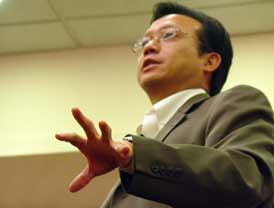|
QUINQUENNIAL CONGRESS XVII, PITTSBURGH, PA * U.S. SECULAR FRANCISCAN ORDER |
Be Aware of Differences in Communication Styles
|
BELOW: Some participants share insights
|
By BOB and MARY STRONACH, SFO PITTSBURGH, PA, July 5, 2007 -- The first step to being sensitive to cultural issues is to know oneself, Fr. Eric Law re-emphasized in his second keynote address July 5. Sharing with another opens the door to not only learning about the other person, but also to continuing to discover oneself, said Father Law, an Episcopal priest, author, and authority on multi-cultural issues. Keep in mind respectful communication, he said, and the willingness to listen, inviting the other to speak. He said he noticed a common thread in the previous day’s small group sessions: “When one person speaks, all energy is focused on that person.” The opportunity to share is always there; “that’s what empowerment is,” he noted. Borrowing from cultural anthropologist Edward Hall’s analysis in the book, Beyond Culture, Father Law described two basic communication styles – low context and high context. Low context refers to being direct, no-nonsense, getting the job done or problem solved in a linear, straightforward fashion. High context means preferring a lot of shared experience, and being group oriented, with a focus on relationships and an indirect non-confrontational attitude. Most everyone, while generally leaning toward one style or another, may employ both types of communication. But it helps to be aware of where someone is coming from, or which style is more comfortable for him or her. Typically in the business and financial world, the no-nonsense, low-context attitude may dominate, he noted, whereas in the arts, high-context communication may prevail. “There’s no such thing as a low-context novel…a low-context poem.” Father Law said he would give an example of a low-context/high-context conflict, and do so in a high-context way, by telling a story. When he was a seminarian, Father Law was assigned to help out at a Chinese parish, and tasked with making sure the parish would be ready for a visit by the bishop. From his seminary training, he wanted to make sure the job got done methodically and as straight-forward as possible. He met with two elders of the parish to discuss what banner should be carried in a procession to welcome the bishop. One elder mentioned he thought a particular banner was beautiful. The then-seminarian said he thought the other banner was better and should be used. Hearing no objection, he made the decision, and the procession and bishop’s visit came off without a hitch. Two weeks later, he received a call from the Episcopal Church’s national office for Asian-American relations. “Eric, what did you do? I just heard you are terrible with old people!” “Don’t worry,” he responded. “I’ll fix this.” After he hung up the phone, he realized he had no idea what to do, which made him think of how when he was younger, he would go to his mother for advice. So he called up a mother figure in the parish and explained what had happened. “Don’t worry,” she told him. “It’s fixable. You and I are going to invite the elders out to dinner, and you’re going to pay, so bring a lot of money…We’ll talk about everything except the banner…That way it will allow everyone to save face.” Two weeks after the arranged dinner, the national office for Asian-American relations called again. “Eric, what did you do? I just heard you’re wonderful with old people!” |
  |
  |



3252a.jpg)
3249a.jpg)
3213a.jpg)
3164a.jpg)
3218a.jpg)
3194a.jpg)


